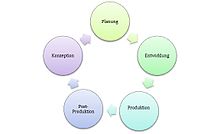Production process in the theater
The production process in the theater includes the genesis of the stage performance of a play from the first conception through development, planning, production to presentation on the stage. The production cycle preceding the creation of the fixture list , both as part of the theater management .
Conception
In the conception phase , a basic idea is checked for its artistic, economic and technical feasibility and modified if necessary. The directing team develops an initial idea for implementation, puts together a team and an initial cast list and presents this concept to the theater management. This includes a first draft budget for the stage, costumes and the engagement of guests. The management creates a cost estimate and compares this with the budget of the position in the plan. The Technical Directorate is examining the possibilities and requests changes due to technical restrictions at an early stage.
development
In the development phase, the conceptually tested piece idea is brought to the schedule position. The director and department head ( acting director , oa) establish the artistic team (director, dramaturge , stage and costume designer , video, light, mask, possibly speech and combat training) and create an initial cast of theater artists who are involved in the production should contribute. In these negotiations, directors like to get guest actors with whom they work regularly. This can lead to frictions in one's own ensemble if protagonistic roles are given to guests. At the same time, the director, dramaturge and set designer continue to work on the concept. Discussions between the management and the director about the size and possible costs of the team, budget, guest fees and additional positions for video or music will also be intensified. The managing director reflects the financial plan to the directing team and points out that the costs of a production naturally always increase, which is why financial reserves for unforeseen developments (unforeseen) are very important.
planning
In the planning phase , all planning instruments (finance, rehearsal, schedule, technical disposition, cast and construction rehearsal) are adjusted to the production to be planned. The rehearsal and game disposition is determined by the employees of the operations and technical office: This includes the rehearsal and game schedule, the coordination of the cast and the technical disposition. In addition, the financial planning is determined by the management: How high is the production budget? Is the financing secured? Which other guest contracts have to be drawn up? Is it possible to raise additional sponsorship funds? Another important point of planning is the construction sample , in which the stage design is reproduced in its original scale, so that precise drawings and templates can later be delivered to the workshops. Finally, the cast in its (temporarily) final version is approved by the director and finally by the management team and posted publicly and centrally. The departmental director or general manager has informed the cast and vacant actors ahead of time.
production
In parallel to the intensive rehearsal and rehearsal process, the set , costumes and masks for production are made in the workshops, technically set up on the stage and already used for the final rehearsal process. At the same time, the employees in the marketing department and the ticket department are working on boosting ticket sales. For fixed program positions in the opera , which are often planned two to five years in advance due to the early engagement of guest singers and conductors , the application usually starts earlier.
Due to the repertoire system , several production processes usually take place in parallel in different rehearsal rooms. This enables the theater to secure the abundance of pieces in the repertoire.
Post production
The fifth and final phase of post-production includes regular performance and its support through active marketing and sales. Beginning with the premiere, the work is performed over a certain period of time as planned (schedule, disposition ) until this process phase also ends with the last performance. In this phase, the artistic director, the operations office and the lead assistant / game master are responsible for maintaining and developing the quality of the piece, while the management ensures that the costs are kept. The visitor service takes care of addressing the public directly and distributes tickets. If the number of viewers drops drastically, the operations office, visitor service and management set a date for the last performance with the director and the division management. In this phase at the latest, the first ideas and concepts for new productions in the following season will be developed. If there is a good cooperation with a directing team, the theater management will possibly arrange another director for the coming season, and permanently engage guest actors in the ensemble for the next season . The production cycle continues.
literature
- Gary Gillet, Jay Sheehan: The Production Manager's Toolkit. Successful Production Management in Theater and Performing Arts . The Focal Press Toolkit 2016. ISBN 978-1-13883884-0
- Nicole Gronemeyer, Bernd Stegemann: Director , Berlin: Theater der Zeit 2009. ISBN 978-3-94073733-5
- Thomas Schmidt: Theater Management. An Introduction , 2012. ISBN 978-3-53118369-5
- Thomas Schmidt: Theater, Crisis and Reform. A criticism of the German theater system , Berlin: Springer 2016. ISBN 978-3-658-02910-4
